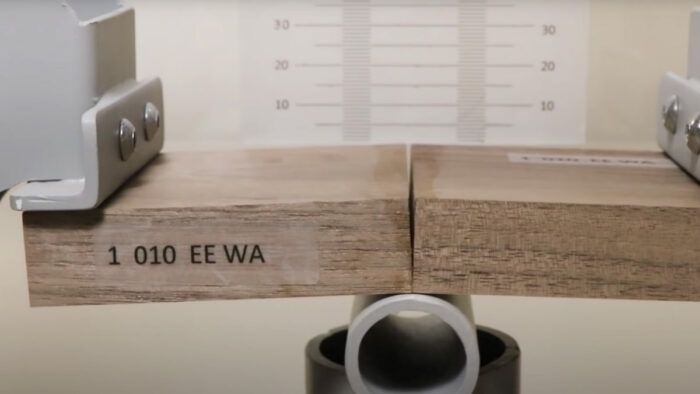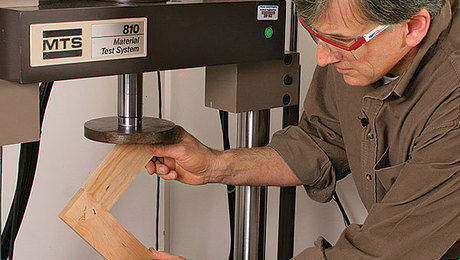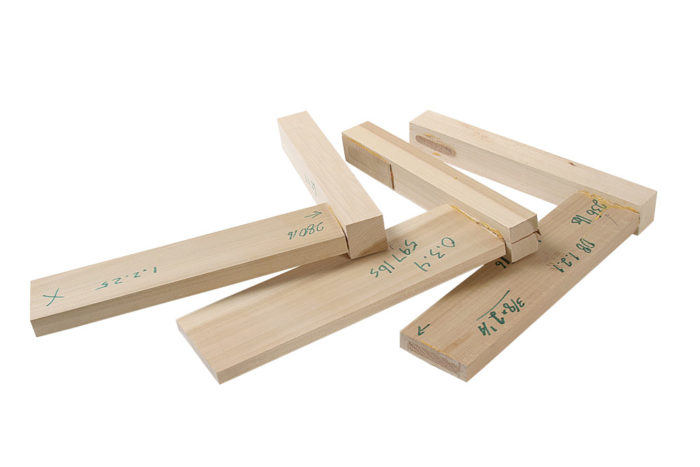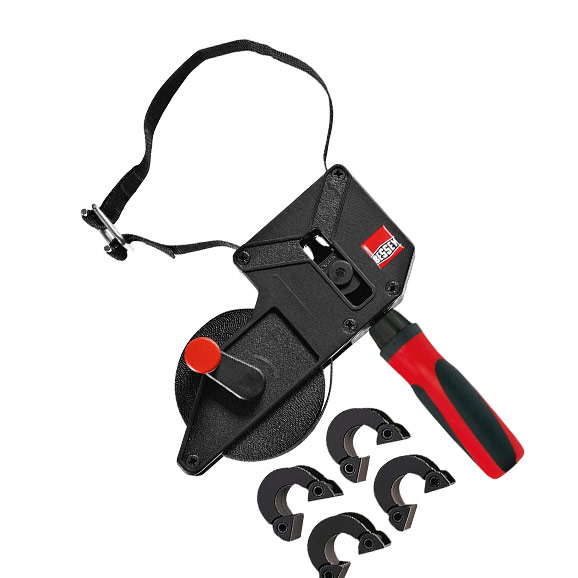Let’s talk about the end-grain glue joint video
Although the methods seem valid, the practical uses of this joint are probably few and far between.
If you pay attention to the woodworking sphere on YouTube, you have seen a video by Patrick Sullivan called “Glue Myths: 1. End grain” (posted below). I have been a fan of Patrick’s videos for a while now (I highly recommend his DIY DRO video). Even so, I scrolled right past this video when I was first served it a week ago. I figured it was going to just confirm what I already knew: End grain glue joints aren’t a great idea.
Soon after the emails, Instagram DMs, forum posts, and comments started coming and coming, and I finally watched the video. I was wrong. The video did not confirm my beliefs.
First off, watch Patrick’s video:
Wow! Right? Patrick’s methods seem as sound as can be–although I’m sure a few engineers will argue otherwise in the comments below (please do!).
My thoughts and opinions are my own here, and they’re still being formed the more I absorb the video and think about it. In Patrick’s testing, end-grain to end-grain joints perform better than side-grain to side-grain joints. I have a hard time arguing with the methods, so I can’t argue with the results. But I think the online community is grossly overestimating what these results mean. I can’t speak for Patrick*, but I think he would agree that people are getting a little too excited about the possibilities afforded by a new world of end-grain to end-grain joints!
#1 – The results aren’t that surprising
Anybody who has ever seen a 7-year old karate chop a pine board in half knows that the wood always splits between the long grain fibers as opposed to across them. What Patrick’s video shows is just that, with two added data points; end grain to long grain and end grain to end grain.
If you look at the results from Douglass Moore and Tom McKenna’s joint test article in 2009, you’ll see exactly the same thing; joints almost always fail when the long grain fibers tear out. As they state in the article:
When we looked closely at how joints tended to fail, we found a clear correlation with our test results. The stronger joints forced their component pieces to fail by fracture across the grain or right at the glue joint (miter), while with the intermediate-strength and weakest joints, failure occurred by the splitting of one piece along the grain.
The strongest joints are joints that work cohesively with everything around to keep everything in place. In fact, Marc Spagnuolo posted a fantastic response video (around the 5:30 mark) that drove this point home nicely.
#2 – Over time, I think wood movement would make all of this moot
Wood is going to move across its width. You can’t stop it, so all of your newfound cross-grain glue joints that performed so well in Patrick’s video are not likely to perform that well after a year or two of movement. I really hope that Patrick sets aside a few of these blanks to test in a year or two. Even better, I’d like to see the performance of these cross-grain glue-ups on a larger scale.
#3 – I can’t remember a time I wish I could have gotten away with a butt joint.
For the same reasons I don’t use pocket screws as permanent joinery, I can’t imagine an instance when I would be using a butt joint in any piece of furniture I cared about. Joinery not only gives you the strength you need for long-lasting furniture, but it makes everything easier to assemble. If you’ve ever tried to keep a glue-laden board perfectly in place while applying the appropriate clamping pressure, you know that it’s almost an impossible task. Glue is slippery and those boards are going to move all over the place. Joinery holds everything where it is supposed to be.
Let me know in the comments below how you would use an end-grain to end-grain joint, because I can’t think of any examples.
#4 – I have to the rethink justification for my answer on solid-wood chess boards, but not the answer itself.
We actually had this podcast clip sitting here ready for… well… this, I guess.
In episode 222, we discussed a listener’s desire to make a solid-wood chess board. One of my main justifications for advising that they not do that is because of the weakness of the end-grain joints that would result. We came up with a few methods of working around the problem (rabbeting the joints and inlaying blocks into a solid piece) but after watching Patrick’s video, I’m starting to rethink this one particular use case for end-grain glue joints. In the end though, I still worry about wood movement eventually taking its toll on a chessboard. Patrick’s video really makes me want to try to build one though and I’m hoping to do so soon. Of course I’ll update the blog reading audience!
Like Marc said in his video, maybe we should all stop saying that there is no strength added to a joint by adding glue to the shoulder of a tenon or end grain of a dovetail. It’s almost cliche at this point, but almost everyone glues that end grain and then extols the pointlessness of it. There is obviously some, if not a fair amount of strength added. Is it worth the squeeze-out it will cause? Or is the answer like everything else in woodworking—maybe?
*Patrick, if you read this, we’d love to have you on the podcast to discuss your video! Email us ([email protected])!
 |
Joinery Shootout |
 |
How Strong is Your Glue? |
 |
Tips for Stronger Tenons |
Fine Woodworking Recommended Products

Bessey Band Clamp

Bessey EKH Trigger Clamps

Starrett 4" Double Square























Comments
Some minor observations about the subtitle. One, just what does "seem valid" mean exactly?! Perhaps one should "determine" whether they are "valid" or not before posting this as the title of the article. Two, the subtitle has a "point and it's counterpoint" set up. The point however about "methods of testing" is not related to "how a joint could be used". They are two unrelated things.
I am not in a position to declare the tests valid or not. I'm not an engineer, and I wasn't there for the experiment.
Ben's #2 argument is a valid counterpoint to the method of testing as the failures seen in the method of testing are not the same as failure caused by wood movement. The test in the video is one of tensile stress whereas glue line failure of the type of joints tested would be a result of shear stress in most, if not all, cases in which it might be used.
My joinery always has . . . joints. The strongest mechanical connection between parts that I can make. Some get dovetails, mortise and tenon . . . whatever the application calls for.
I always add glue to the end grain on dovetails. It's easier than trying g to keep it off the end grain, and there is a lot of end grain.
I don't put glue on the end grain on tenon shoulders. The acreage is small, and putting glue there makes a mess.
I glue long grain to long grain for one reason only -- to make boards wider. A simple glue joint is all I need. It's plenty strong, because it is never structural.
The only reason I can see to glue end grain to end grain is . . . I can't think of a single reason. To make a board longer? No thanks.
If anyone can show me a situation where I would need an end grain to end grain joint, I'd be glad to hear it.
Well, there is a lot of finger jointed stock on sale in all the big box lumber stores. But although a finger joint looks like an end to end grain connection on a macro scale, the fingers supply a lot of surface which approaches a side grain connection.
But finger jointed wood is almost always trim, where the main structure provides the support and the joint is unlikely to see much stress - at least if used correctly.
One caveat: I was remodeling a house some years back which had finger jointed brick mold trimming the exterior all of its many doors. I was busy removing it all and replacing it with fresh brick mold because all of the old trim had started to visibly separate (by as much as 1/32" or more in some cases). This points out the danger of something Ben said about evaluating joint strength after aging to include effects of wood movement. Now, I cannot say for sure whether the problem was wood movement by itself or poor paint protection (which allowed weather to weaken the glue) or a combination effect, but the joints were all gapping at the finger joints as if they were being pulled apart in tension.
And this is what I would expect from an end-grain to end-grain joint (or any type of joint not reinforced by joinery) if it was used outdoors and possibly even if used indoors with a lot of humidity excursions.
Weather and the exposure to sun for finger- jointed is a deadly combination for outside trim. If for no reason that usually they lengths are made up from bad ends of boards that normally would have been waste, so they take scrapes of crap wood and make a crap longer piece of wood. I had some installed on my house on Long Island several years a ago, within in a year the wood on the south side of the house was so punky it all had to be replaced and the finger were separating as well. Maybe for inside trim but, never outside in my humble opion
I still have a very simple solid wood chess board made in 8th grade shop class in 1970. Maple and mahogany. Rather beat up after more than 50 years of use in a family with lots of kids. But it's still together and plenty strong for it's purpose.
The engineer in me wants to test it to destruction to see how strong it is, but it has too much sentimental value for that.
I agree with everything John_C2 says except for the occasional example of a small low stressed item like this.
You wouldn't want to make a table or cabinet this way, and you can't attach a solid wood border to a chess board like this without allowing for wood movement.
That's a good example!
One point about end-grain joints: getting reasonable strength is going to be very dependent on how glue is applied. End grain is the most porous face of any wood. If glue is simply wiped across the face, the joint can easily end up starved for glue as the glue soaks into the pores. Anybody that really pays attention to the effect of glue on end grain will likely go back over the surface and add more glue before fitting the joint. This effect alone could be responsible for a lot of our "tribal wisdom" about weak end-grain glue-ups.
My question - and I am not anywhere near the engineer to answer it - is that I see a disconnect in the conclusion. To my viewing, EVERY end/end joint failed at the glue joint, but NO end/side or side/side joint failed at the glue joint. Those failed where we expected - along the grain. The end/end joint is oriented where both pieces are at their strongest. In the other two one or both is oriented to their weakest. So, the conclusion of the original video could have been that side/side and end/side the glue joint is stronger than the wood, but end/end the wood is stronger than the joint. This would seem to be the opposite conclusion.
To further (and maybe more clearly) clarify - to me there are two data points missing in the original study. What is the 'along the grain' breaking strength of each sample, and what is the failure point of the glue joint in the side/side and side/end samples if the wood does not break (not sure how you would accomplish that).
I suspect the myth wasn’t actually a myth but a truth…long before modern PVA became our standard. 40, 50, 60 years ago, woodworking glue was hide glue and some aliphatic resins IIRC.
I’ve seen plenty of old furniture, with brown glue joints, where the glue appeared to have crystallized and shattered throughout the joint. It was my grandfather who told me 50-years ago: “Glued end joints, don’t do it.”
Technology may have rendered the truth into a myth.
Very good point!
Well I don't know where Marc Spagnuolo came up with his engineering degree to get his calculations, but I think you need to go back to school. You may be correct in that all the joints combined are stronger, just not at four times the strength of one joint. It gets a little more complicated than that, it could calculate out to more, or less depending on the joints, where they're located, the species of wood, etc., etc., etc.
End grain to end grain rarely comes up in my experience but side grain to end grain is in every project. Face frames for kitchen cabinets get glue plus reinforcement in the form of pocket screws, dowels, biscuits, or in the modern world, dominoes. Glue clearly helps these joints stay tight over the long haul. Here it another example. The joints in these rail panels at 30, 60, and 90 degrees are screws and glue. Even the side panels with 90 degree joints and screws going into end grain are very rigid in all directions. I stood on them because I was curious. Clearly the glue is supplying a lot of rigidity. We are now in the long term environmental testing phase. The panel are under the roof of a screened porch, not subject to saturating rainfall but at the mercy of seasonal humidity changes. Check back in 50 years. I won’t be here but I predict the railing will be fine. If you have end grain in a joint, put glue on it it will help.
Interestingly, based onthese results, it seems miter joints might be very strong because they are hybrid end grain joints that effectively get the long grain to turn a corner.
The biggest potential problem with glued miters is something he didn’t test for — wood movement. In a miter joint, the movement of the wood changes the angle of the miter, creating some interesting stress vectors in the constructed piece as, for a simple example, a mitered box attempts to hold cohesion with angles totaling (variously) more or less than 360 degrees. It’s possible today’s glues could stand the strain, especially with thin-walled polygons, but I’ve never seen a large glued miter that didn’t fall apart at the glue joint over time. (Yes, that’s merely anecdotal evidence and should not be taken a proof.)
If you’re fishing for my own POV, since the glued end-to-side is demonstrably weak, I don’t much care whether it’s the glue or the wood that fails — either way the joinery fails, so I should use a different technique. And since I suspect the (untested) finger joint end-to-end is stronger than the butt joint version, I’ll use it.
End grain. He wasn't promoting the use of end grain to end grain but showing the fallacy in the myth that it is weaker than long grain, side-to-side glue-ups. Looking at the amount of force it took to create a failure you shouldn't worry if your project needs to use this technique. It also should take the fear out of (How do I reinforce this miter joint to insure it doesn't fail because it's end grain to end grain.) The glues made today should give you more confidence in your projects and quit worrying about the fact that, OMG how do I deal with this connection and prevent a future catastrophe. Besides, if your project is going to be subjected to that much force then side grain glue-ups ain't gonna help you at all. It's light bulb time for us all. Even if we want to deny it. The video was a breath of fresh air for me. Now I know what to do when I, UH-OH, cut a board too short. Cheaper than a finger joint router bit. Think about how you can now make use of the scrap bin with confidence. Especially when you need a longer caul for glue-ups or a brace when assembling a project. Bet you can think of many ways to take advantage of this knowledge. Especially in casework where there are a lot of hidden parts. The materials we use to create our masterpieces are not getting any cheaper.😊
There is a variety of reasons to glue two pieces of wood together and many ways to accomplish it. I think we err by concluding that we need to make all joints strong enough to withstand the stress of completely different applications. In the chess board discussed in the last video, I wouldn't hesitate to glue end grain. The question as stated says it will be frame and panel, so there will be a long grain frame around the chessboard squares which will add strength. As long as the chessboard is not bashed about, I would expect it to last far longer than the maker. One time I needed to weld a cast iron tool rest (for a lathe) to a regular steel post. I asked the welder about the "never weld cast iron to steel" rule. He said, "This won't hold up a bridge, but it will hold the tool rest." I've used it for a couple years and he was right.
This test is interesting by I agree it really doesn't mean much for a woodworker. A more relevant question for a woodworker is: "what happens to the furniture we make over long time periods when constructed in different ways?" And we all know that end-grain joints that aren't reinforced in some way commonly fail. Picture frames, door casings, etc. pull apart at the miters, as does mitered casework.
Log in or create an account to post a comment.
Sign up Log in